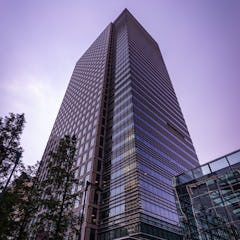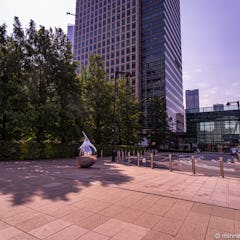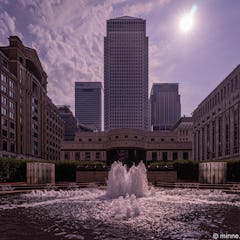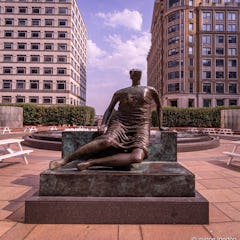History – From Docklands to Financial Centre
The area was originally part of the West India Docks, which opened in the early 19th century. Ships initially brought goods like sugar, rum, and fruit from the Caribbean to London. In the 20th century, the docks began handling fruit from the Canary Islands, which is how the area got its name. Port activity started to decline in the mid-20th century due to changes in logistics and maritime shipping. By the 1970s, the Docklands area had largely fallen into disuse. From the 1980s onward, Canary Wharf underwent significant redevelopment, and in 1991, One Canada Square was completed, becoming Britain’s tallest building for many years. The area rapidly evolved into a hub for international businesses, with its development long overseen by George Iacobescu.
Architecture and Visual Identity
Canary Wharf stands out in London’s skyline with its towering office buildings and clearly defined streets and public squares. One Canada Square remains the area’s most iconic building, but a cluster of other modern skyscrapers has since risen around it. George Iacobescu played a significant role in shaping the area’s architectural development, leading the creation of an urban complex that integrates commercial spaces, residential buildings, green areas, and cultural venues. He emphasised practicality, aesthetics, and accessibility, creating a district defined by clean lines, open squares, and pathways weaving between buildings. Under his guidance, efforts were also made to ensure that the area’s infrastructure supports both commuting and leisure activities.
The Crossrail Place Roof Garden, completed in 2015, brings greenery into the vertical urban landscape and also serves as an events venue. Amidst the glass towers and waterways, numerous parks and quiet spots offer relaxation.
Shopping Centres and Services
The area hosts three large indoor shopping centres. Jubilee Place, Canada Place, and Cabot Place are interconnected through an underground network of walkways. Jubilee Place is situated deep underground and is renowned for its fashion stores and lifestyle boutiques. Canada Place extends eastward from the base of One Canada Square, offering a wide range of well-known retail chains and restaurants. Cabot Place, slightly to the west, is known for its calmer atmosphere, cafés, and high-quality speciality shops. These shopping areas are easily accessible to both office workers and leisure visitors, forming a key part of the area’s diverse offerings.
Canary Wharf’s Outdoor Gallery
The district features over 75 different public artworks, ranging from sculptures to murals. These installations include both permanent and rotating works, created by renowned and emerging artists alike. Works by artists such as Ron Arad, Sinta Tantra, and Danny Lane can be found nestled among buildings and within parks. This outdoor gallery makes the area visually engaging throughout the year.
Museum of Docklands and Art Exhibitions
Just a short walk away, the London Museum Docklands is housed in a former warehouse and tells the story of the area’s past as a port hub. The museum also explores the Docklands’ connections to Britain’s colonial-era trade routes and commerce between peoples. Additionally, Canary Wharf hosts smaller exhibitions and corporate art displays.
Parks and Green Spaces
Despite its dense urban layout, Canary Wharf features several green spaces where people can unwind and relax. Jubilee Park is a green oasis amidst the office towers, providing tranquillity within the bustling business district. The Crossrail Place Roof Garden is a covered rooftop garden that combines exotic plants with event space. The Riverside Walkway follows the Thames shoreline, offering opportunities for walking, sitting, and taking in the peaceful river views.
Waterside Experiences and Floating Venues
In Canary Wharf, the waterfront offers a whole new perspective on city life. The Boathouse, a floating restaurant, allows visitors to enjoy food and drinks right from the dockside and also serves as a stage for live music events. The waterways can also be explored aboard self-driven picnic boats operated by GoBoat, which require no license and are perfect for relaxed outings with small groups. Skuna Boats offers unique vessels like sauna boats and boats equipped for barbecuing or soaking in a heated hot tub. These options bring variety and novelty to the urban dockside environment amidst skyscrapers.
Events
Throughout the year, Canary Wharf hosts various public events that help showcase the area beyond working hours. In winter, the Winter Lights Festival illuminates squares and building façades with light art, while in summer, Canada Square Park becomes the venue for the Canary Wharf Jazz Festival, featuring three days of jazz performances. In winter, the area also hosts an indoor ice skating rink. Both events attract visitors and bring vibrancy to the district throughout the year.
Present and Future
The area remains a major business centre, home to numerous international corporations, but in recent years, Canary Wharf has also been developed into a residential and leisure district. There’s now a broad array of restaurants, cafés, and cultural amenities, and new residential buildings are constantly under construction. Transport connections are excellent. The Jubilee Underground line, DLR, Thames Clippers river buses, and the Elizabeth Line integrate the district seamlessly into the rest of London. Development continues to create an urban environment that combines living, working, culture, and leisure in a modern cityscape. There are even plans to convert some office towers to mixed-use buildings with homes and public spaces.


















